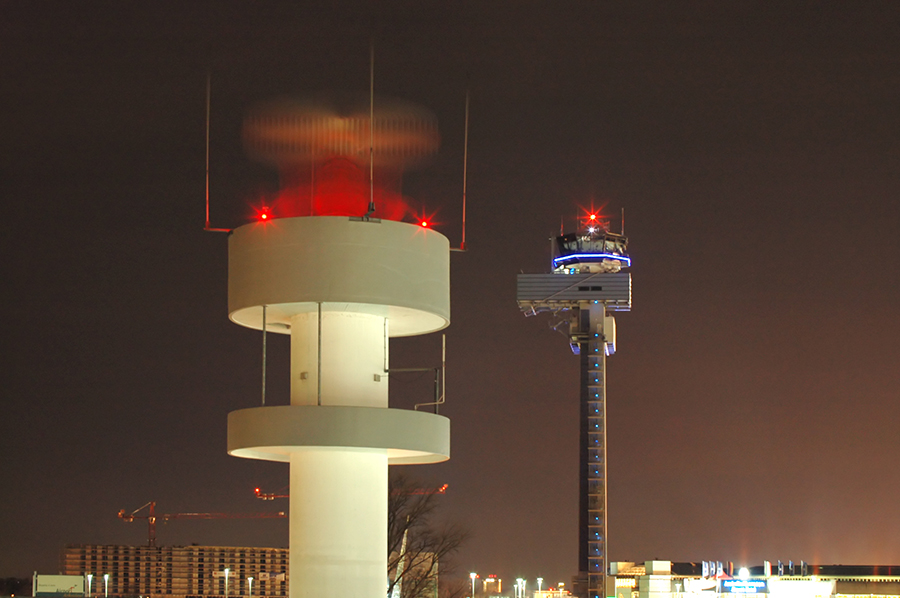-
Key Takeaways
-
What Is Clear Air Turbulence?
- Why Is CAT Hazardous?
-
Causes of Clear Air Turbulence
- Wind Shear
- Jet Streams
- Mountain Waves
- Temperature Inversions
-
Where Clear Air Turbulence (CAT) Happens
- High-Altitude Regions
- Vicinity of Jet Streams
- Mountainous Areas
-
Predicting and Detecting CAT
- Limitations in Detection
- Tools and Indicators
- Signs to Look For
-
Handling CAT in Flight
- Preparation and Flight Planning
- In-Flight Strategies
- Passenger and Crew Safety
- Airplane News Update
- Reporting CAT Encounters
-
Case Studies of CAT Incidents
- Lufthansa Flight 469 (2023)
- United Airlines Flight 826 (1997)
- Lessons Learned
-
Frequently Asked Questions
- Can Clear Air Turbulence Bring Down an Aircraft?
- Can Pilots Detect Clear Air Turbulence?
- At What Altitudes Does CAT Usually Occur?
- Is CAT Becoming More Frequent?
-
Conclusion
Imagine you’re cruising smoothly at 35,000 feet. The sky is clear, and a jetstream wind gently carries you forward. Then all of a sudden, and without warning, you’re rocked violently by an invisible force.
Welcome to the world of Clear Air Turbulence (CAT). These weather events are fierce and brutal, and what’s worse is that you never see them coming.
But despite being unpredictable, they’re something you can arm yourself against. How can you stay safe during high-altitude flights?
Let’s take a closer look at clear air turbulence, so you can anticipate where they might show up, and learn how to manage the risks involved.
Key Takeaways
- Clear air turbulence is sudden, invisible turbulence that occurs at high altitudes in clear skies.
- Jet streams, mountainous areas, and high altitudes are more likely to have CAT.
- Upon a CAT encounter, configure to turbulence penetration speed and maintain control.
- Weather reports, forecasts, and PIREPS are the best way to identify and warn others about CAT.
What Is Clear Air Turbulence?
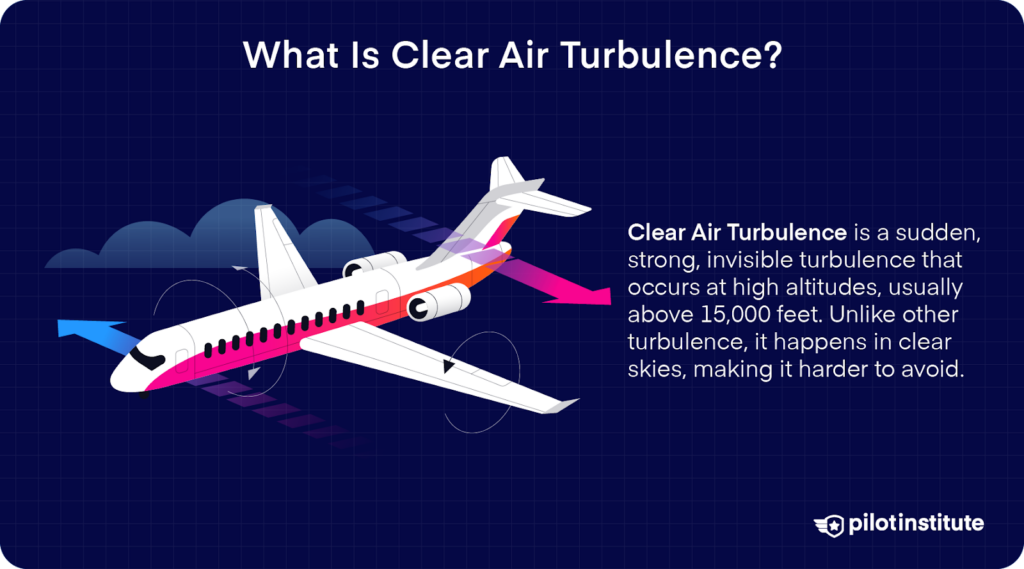
Clear air turbulence is a kind of strong, sudden shaking that aircraft can experience while flying at high altitudes, usually above 15,000 feet. And unlike other types of turbulence, CAT happens in clear skies, not inside storms or clouds, so it’s much more challenging to avoid.
Where are you most likely to fly into CAT? They usually occur near jet streams. They’re fast, narrow air currents in the upper atmosphere.
Other places you might find CAT are:
- Inside or near thin, wispy cirrus clouds.
- Around standing lenticular clouds.
- In clear areas near thunderstorms, even if you aren’t flying through the storm itself.
What’s not included in CAT are weather inside thunderstorms, low-altitude temperature inversions, thermals, strong surface winds, or local terrain features. That is to say, clear air turbulence is a whole other beast.
Why Is CAT Hazardous?
The danger about clear air turbulence is that it often happens without any warning. Since it forms in clear skies, it’s an invisible hazard.
There are no clouds or other visual clues to show that turbulence is ahead. Unlike those found around thunderstorms, where you can easily spot trouble, CAT can strike suddenly in what appears to be calm air.
You can’t rely solely on what you see to steer clear of CAT. And when it hits, it can cause the airplane to suddenly drop, rise, or tilt sharply.
What are the consequences of this? First of all, the sudden and quick movements can affect crew performance and the stability of your aircraft.
You might temporarily lose your controls if you don’t handle it properly. Even simple tasks like reading your instruments might become near-impossible.
You should also consider how this force affects your passengers and crew. If people on board aren’t wearing seatbelts, or if items in the cabin aren’t secured, the sudden jolts can cause serious injuries.
In fact, according to a 2021 study, the National Transportation Safety Board (NTSB) found that turbulence was involved in more than one-third of U.S. airline accidents between 2009 and 2018.
And that’s to say nothing of the impact on the aircraft itself. If the turbulence is especially strong, it can cause stress to the aircraft’s structure, and even potentially cause damage over time. This kind of damage could cause the aircraft to break apart in extreme cases.
Even in less intense turbulence, parts inside the aircraft can sustain damage, especially if loose cargo or luggage crashes into them.
Causes of Clear Air Turbulence
How does clear air turbulence even happen in the first place? If the sky is clear, why is the aircraft shaking so much?
Clear air turbulence doesn’t need stormy weather to show up. The answer lies in hidden forces that move through the atmosphere. Let’s break them down.
Wind Shear

Wind shear happens when the wind suddenly changes speed or direction over a short distance, which creates turbulence.
It often happens vertically, but it can also occur horizontally. This is why wind shear is described as either vertical or horizontal, depending on the direction of the change.
You might think you’re off the hook from wind shear since you’re high up, but it can happen at any altitude.
It might occur high in the sky near jet streams or lower down near the ground. You might also encounter it around storms or during strong weather changes.
What happens when you fly through wind shear? Your aircraft can suddenly be pushed upward or downward, or it might speed up or slow down without warning.
You might sometimes hear the term “severe wind shear.” This usually means the wind change is stronger than what the aircraft is built to handle safely, like sudden airspeed changes of more than 15 knots or vertical speed shifts over 500 feet per minute.
Jet Streams
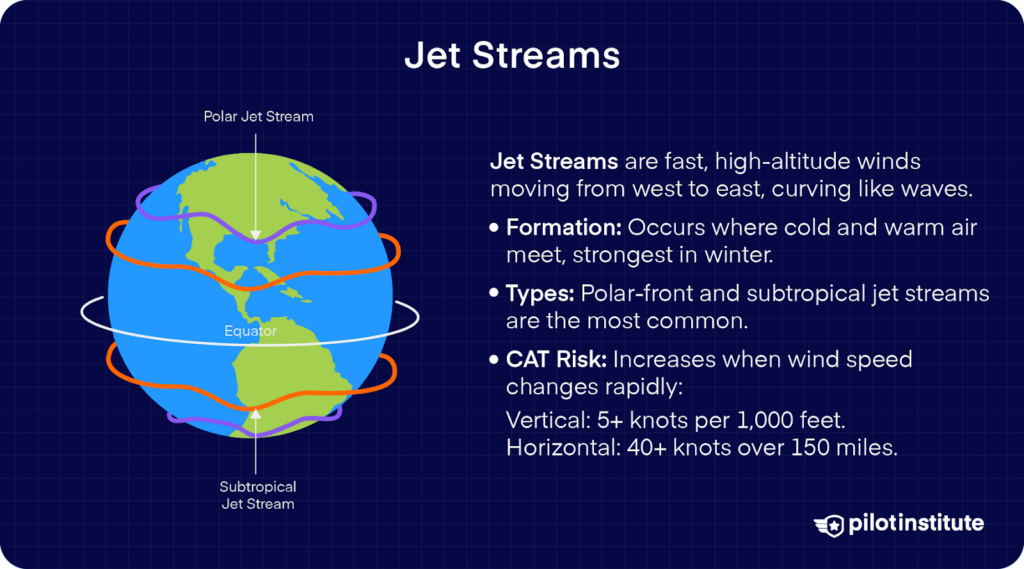
Clear Air Turbulence (CAT) often happens near something called jet streams. They’re fast-moving, narrow bands of wind high up in the atmosphere that blow from west to east.
They don’t move in a straight line, but instead twist and curve. They dip southward and rise northward, kind of like waves.
How does a jet stream happen? Jet streams form where cold and warm air meet, and because that temperature difference is strongest in the winter, jet streams are also strongest during that time.
There are three main jet streams, but the ones you’ll hear about most are the polar-front jet stream and the subtropical jet stream.
Clear air turbulence usually becomes more likely when wind speeds in the jet stream reach around 110 knots. But it’s not just the fast wind that causes the turbulence. Rather, it’s how quickly the wind speed changes.
Imagine the atmosphere getting pulled in different directions, which can cause it to ripple or even flip over in places. One part of the air is moving very fast, and the air right next to it is moving much slower.
Sound familiar? We’re back to talking about wind shear.
Clear air turbulence becomes more likely when:
- Vertical wind speed changes by 5 knots or more every 1,000 feet.
- Horizontal wind speed changes by 40 knots or more over 150 miles.
Mountain Waves
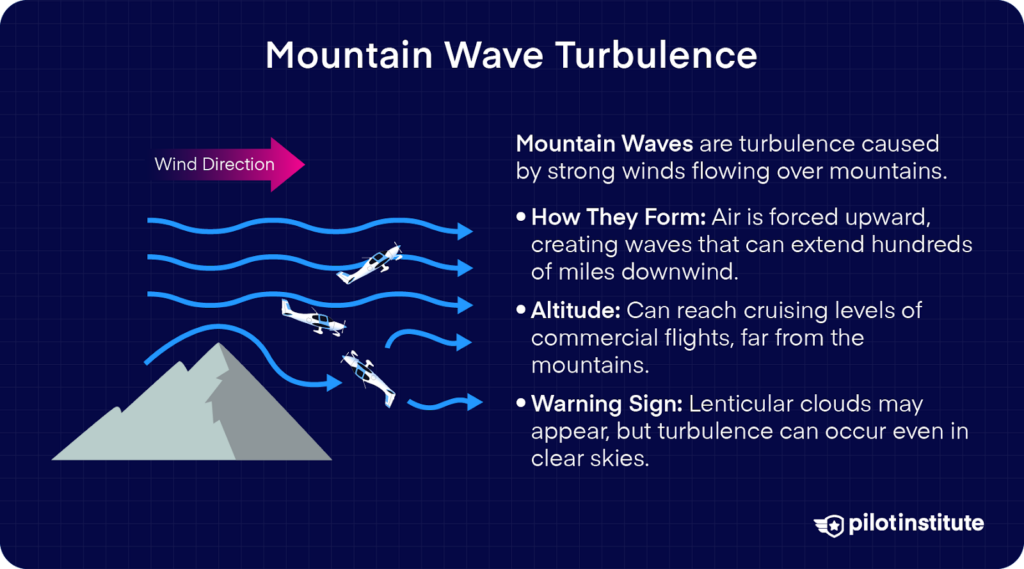
When strong winds blow across mountain ranges, the air is forced to move up and over the peaks. As the air flows towards the other side, it can start to develop eddies of turbulence.
These are called mountain waves, and they can also cause strong wind shears.
What’s tricky about mountain waves is that they don’t just stay close to the mountains. They can stretch far downwind, sometimes hundreds of miles away from where they started.
This means turbulence caused by mountains can show up even when you’re flying nowhere near them.
Mountain waves can also push turbulence much higher into the sky. In fact, the waves can reach the same altitudes where commercial flights cruise, well above the mountains themselves.
Sometimes, mountain waves form lenticular clouds, which look like smooth, lens-shaped layers. But the problem is, these clouds don’t always appear. Turbulence from mountain waves can happen even when the sky looks completely clear.
Temperature Inversions

We all know how temperature decreases with altitude, most of the time. But there are also places where the opposite happens. A temperature inversion is a layer of the atmosphere in which temperature increases with altitude.
These typically occur when the air close to the ground gets colder than the air above it at nighttime. This tends to happen along frontal zones and when cold air is trapped in a valley.
The danger in an inversion? The strong wind shears across its layers, which can generate turbulence.
Where Clear Air Turbulence (CAT) Happens
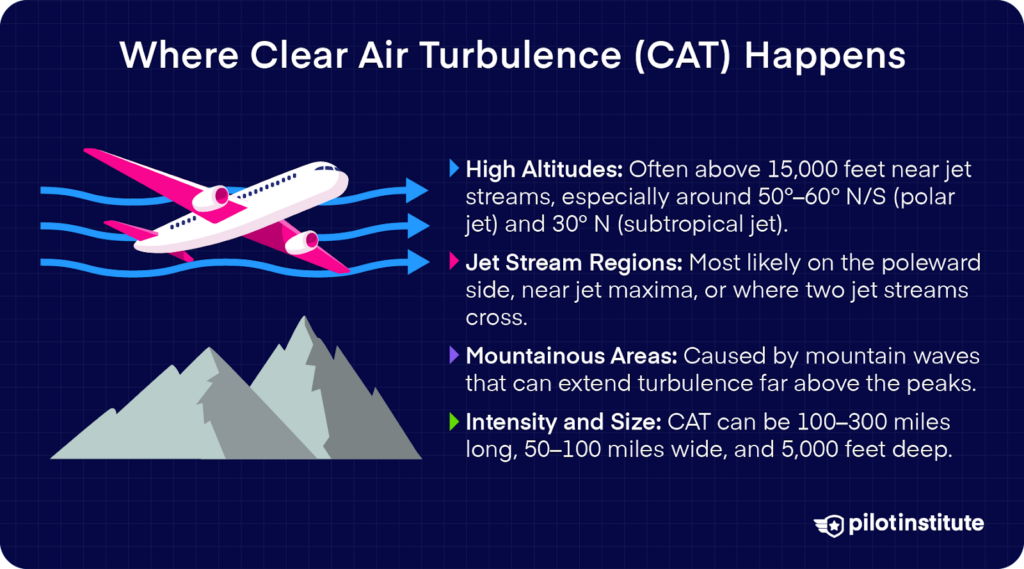
Clear air turbulence can happen anywhere at any altitude. But with that said, you’re more likely to find them in certain places than in others.
High-Altitude Regions
One of the most common places where you’ll find clear air turbulence is at high altitudes. Above 15,000 feet is where jet streams usually reside, and there’s a chance you’ll encounter CAT at their cores.
The 50°–60° N/S latitude region is where the polar jet is located, and the subtropical jet is found around 30° N latitude. Jet streams vary in height from FL 200 to FL 450.
When you’re flying near a jet stream, CAT is most likely to happen near the tropopause, which is the layer that separates the troposphere and the stratosphere.
Cirrus clouds can also be found at high altitudes, as well as standing lenticular clouds on top of mountains.
Vicinity of Jet Streams
You’re most likely to find clear air turbulence on the poleward side of the jet stream. In the United States, this is to the left side when facing downwind.
There’s also more turbulence near the strongest wind sections within the jet stream, known as jet maxima.
Did you know that CAT is more likely in certain wind shapes? One common pattern is called a trough. For this, imagine the wind dips down south and then curves back north again, kind of like a U-shape.
The opposite of that is a ridge, where the wind curves upward and then back down.
Another hotspot for CAT is when two jet streams meet or cross paths. For example, sometimes the polar-front jet dips low and passes under the subtropical jet. When that happens, the difference in wind speeds and directions between them can create a lot of turbulence.
Lastly, if a jet stream has winds stronger than 110 knots at its core, there’s a higher chance of rough air just above, below, or to the low-pressure side of it.
The intensity of CAT can vary significantly along any flight path. Clear air turbulence related to a jet stream is typically 100 to 300 miles long, elongated in the direction of the wind, 50 to 100 miles wide, and 5,000 feet deep. They can linger from 30 minutes to one day.
Mountainous Areas
Sometimes, mountain waves form visible clouds—like lenticular clouds, which look like smooth, lens-shaped layers. These clouds can help pilots spot where turbulence might be.
But the problem is, these clouds don’t always appear. That means turbulence from mountain waves can happen even when the sky looks completely clear.
When strong winds blow across mountain ranges, the air is forced to move up and over the peaks. As the air flows towards the other side, it can start to develop eddies of turbulence. These are called mountain waves, and they can cause strong wind shear, leading to CAT.
But even high above a mountain, an invisible danger also lurks.
Mountain waves can also push turbulence much higher into the sky. In fact, the waves can reach the same altitudes where commercial flights cruise, well above the mountains themselves.
Air moving nearly perpendicular to a mountain can be deflected upward and accelerated as it passes over the crests and down the lee slopes of the terrain.
The standing wave can create a domino effect and develop vertically above the mountain crest. This vertical propagation of the wave means that the impact of the mountain range can be felt much higher above the peaks, sometimes reaching even over 60,000 ft.
In fact, the strength of this type of wave actually increases with height above the mountain. This is a consequence of the normal decrease in air density with altitude.
Predicting and Detecting CAT
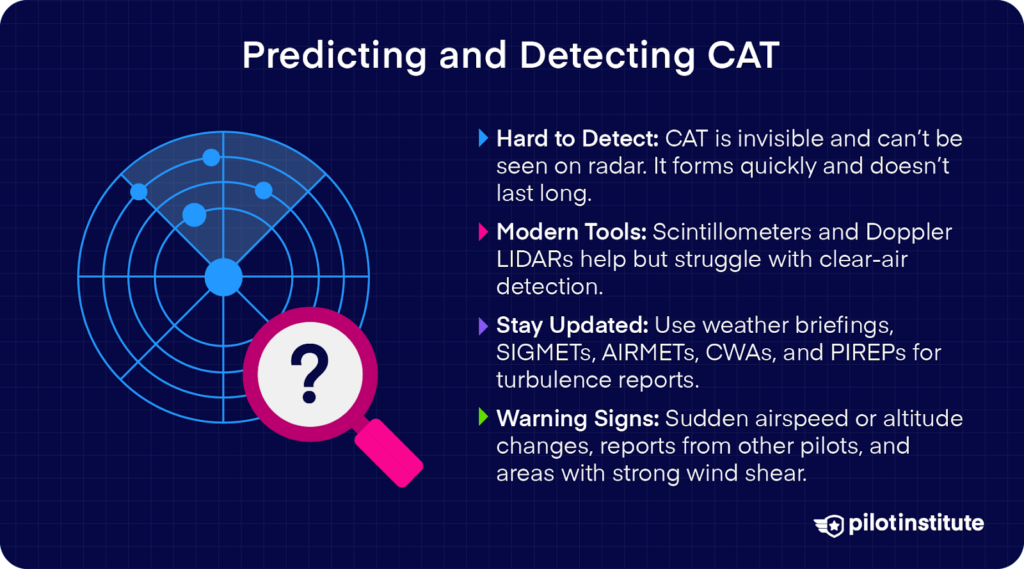
Is it even possible to spot CAT, or at the very least, anticipate where it could be? While it may be hard, you can avoid clear air turbulence when you know where to look.
Limitations in Detection
Predicting and detecting clear air turbulence is a challenge because it usually happens without any visible signs. You can’t see it coming, and even the onboard weather radar can’t detect it.
One of the biggest challenges in forecasting CAT is how quickly it can develop and dissipate. It’s unpredictable, and it doesn’t stay in one place for long.
Modern tools like scintillometers and Doppler LIDARs have improved weather tracking, but they still struggle with detecting CAT.
These systems are better at spotting storms or large weather patterns. CAT, however, happens in clear air and at high altitudes.
Tools and Indicators
Given how hard it is to detect CAT, what tools can you use to stay away from danger?
Turbulence avoidance begins with a thorough preflight weather briefing. Many reports and forecasts are available to assist the pilot in determining areas of potential turbulence.
These include:
- Severe Weather Warning (WW)
- Severe Weather Outlook (AC)
- Center Weather Advisory (CWA)
- Area Forecast (FA)
- Pilot Reports (UA or PIREPs)
In-flight aviation weather advisories are available to pilots through flight service, ATC, and over the hazardous in-flight weather advisory service (HIWAS). These updates come in the form of significant meteorological information (SIGMET) and Graphical Airmen’s Meteorological Information (G-AIRMET).
In the U.S., most of these advisories are created by the Aviation Weather Center (AWC) and by twenty Center Weather Service Units (CWSUs).
The best source of information? PIREPs. Therefore, you must be familiar with the turbulence reporting criteria in the aircraft information manual (AIM). It also describes the procedures for decoding and transmitting your PIREPs related to turbulence.
Signs to Look For
While you can’t see CAT with the naked eye, there are subtle signs that one might be nearby. Did you catch any sudden shifts in your airspeed indicator and altimeter? See any other odd instrument readings? Prepare for a bumpy ride.
Stay tuned to other pilots’ reports and any advisories from air traffic control. ATC often relays turbulence updates from aircraft that have already flown through the area, which gives you a heads-up about any rough spots.
You should also be cautious when flying through temperature inversions or wind shift zones, especially near pressure troughs and ridges.
These areas often have sharp changes in wind speed or direction, which, as you may recall, leads to turbulence. The stronger the wind shear in these zones, the more likely CAT becomes.
Handling CAT in Flight
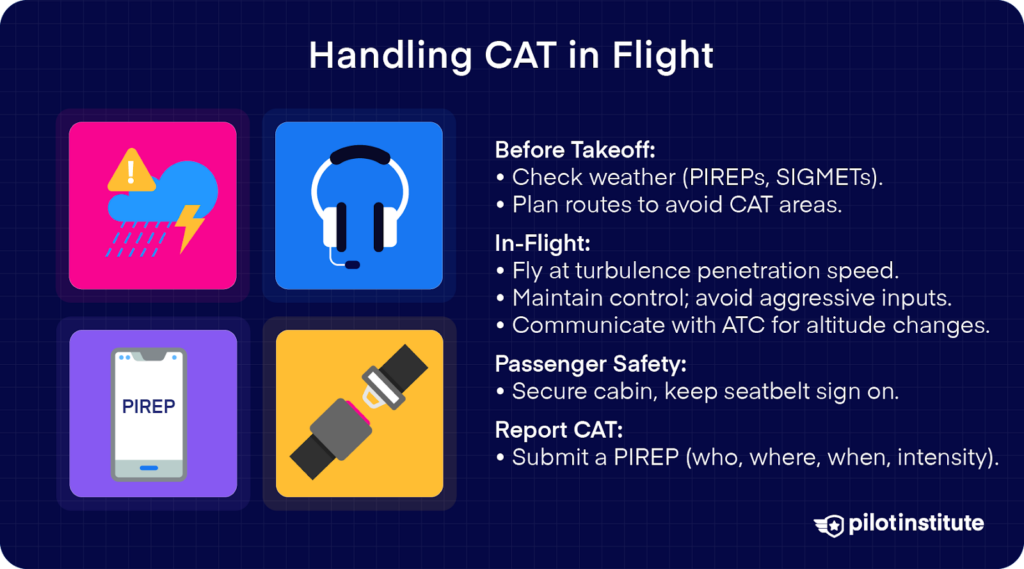
While CAT may seem intimidating and perhaps even impossible to avoid, ensuring your survival is entirely within your power. Plus, there are ways to prevent any unwanted encounters even before take-off.
Preparation and Flight Planning
Everything starts with good preparation. Go through a detailed weather briefing before every flight.
Which weather tools can you use? PIREPS from other pilots and SIGMETS provide valuable information about the weather conditions ahead.
Since conditions can change quickly, stay updated on weather changes along the way and be ready to adapt.
We’ve discussed which places to look out for; pay close attention to forecasts related to jet streams and wind shear. Remember how turbulence can also develop in and around mountains.
Sometimes, simply changing your altitude can lessen the risk. If a route takes you through a CAT-prone area, flying slightly higher or lower could keep you in smoother air.
Avoid these hotspots and adjust your flight plan as much as possible. But if it can’t be helped, your next best weapon is to learn how to handle CAT.
In-Flight Strategies
What if you find yourself in the worst-case scenario? Do you know how to handle clear air turbulence?
Stay calm and maintain control of your aircraft. When flying through CAT, one of the first things you should do is flip through your Aircraft Flight Manual (AFM) or Pilot’s Operating Handbook (POH). Then find the recommended turbulence penetration speed.
If you fly too fast, you’ll worsen the aerodynamic forces that lead to more severe jolts, and worse, structural damage.
You’ll reduce the stress on your aircraft’s structure with a lower airspeed. You’ll also be much more in control.
Keep the wings level and maintain a steady pitch attitude. Your altitude may fluctuate as you fly through the eddies, and you might feel the urge to fight it. Don’t. If needed, let the aircraft move up and down with the turbulence.
Trying to force the aircraft to stay at the same altitude by maneuvering aggressively only adds extra stress. Just check your attitude indicators to stay oriented, and avoid making sudden or strong control inputs.
If the turbulence continues, consider requesting a change in altitude or route from ATC. CAT often forms in thin layers, so climbing or descending even a few thousand feet may help you find smoother air.
The intensity of CAT can vary a lot with altitude, so a small change could make a big difference.
Always keep communication open with ATC. If turbulence is affecting your assigned altitude, let them know.
You might need to request a block altitude clearance—a range you can safely move within—or ask for vectors to help guide you around the rough patch.
This helps maintain safe spacing between aircraft while giving you more room to manage the turbulence.
Passenger and Crew Safety
With everything going on when flying through CAT, your top priority should still be the safety of your passengers and crew. And when it comes to this, a few simple precautions go a long way.
The moment you expect turbulence or fly into it, immediately ensure that the cabin is secured and that all passengers are seated with their seat belts fastened.
Even light turbulence can become dangerous if someone is standing or unrestrained. Switch the seatbelt sign ON. Then, using the Passenger Address system, announce to the cabin requesting passengers and crew to fasten their seatbelts immediately.
Cabin crew are especially at risk during turbulence. But if you keep them safe, they’ll be able to assist others afterward.
They should stop service immediately. Their task is to secure carts and loose items, and once that’s done, take their seats with seat belts fastened.
Since CAT is an invisible threat, it’s a good practice to keep the seat belt sign on even in clear skies. Sudden jolts can come without warning, so staying buckled is your best protection.
Reporting CAT Encounters
A responsible and proactive pilot would warn others of the existing danger right away after a CAT encounter.
You can do this by submitting a PIREP to ATC, an FSS, or an AWC. You’ll be helping other pilots avoid the same area. Plus, you’ll also improve the accuracy of weather forecasting.
Even if the turbulence has passed, a timely report still provides valuable information. So, what should you say when making a report?
It can all be broken down into four parts: who, where, when, and what.
The “who” is pretty straightforward; you should start with your IDENT. For “where” and “when,” mention your altitude and position relative to an airport or navaid. You can also use latitude and longitude. Then, state the time you experienced the CAT.
For the “what,” since we’re dealing with clear air turbulence, this will be the main idea of your report.
Turbulence can be described in four ways according to intensity:
- Light turbulence causes slight and momentary changes in altitude and/or attitude. You may also feel a slight bumpiness. Your passengers could feel a slight strain against their seat belts.
- Moderate turbulence is somewhat more intense, but you still don’t lose any control of your aircraft. Passengers will feel a definite strain against their seat belts, and unsecured objects will be dislodged.
- Severe turbulence causes significant and abrupt changes in altitude and/or attitude. You’ll also find large variations in your airspeed indicator. You may momentarily lose control of your aircraft, and your passengers will be forced violently against their seat belts.
- Extreme turbulence is the most severe. Your aircraft is violently tossed about, and will be impossible to control. Turbulence this intense can cause structural damage.
Sample PIREP Dialogue
What might your report sound like? Here’s an example of a PIREP about clear air turbulence.
You: Denver Radio, United 872 with an urgent pilot report.
FSS: United 872, go ahead with your report.
You: We experienced severe clear air turbulence at flight level 400, approximately 35 miles northeast of DBL VOR. Time was 1547 Zulu. Aircraft is a B777. The turbulence lasted about 3 minutes and caused altitude deviation of about 200 feet. No injuries, but we’re requesting lower due to persistent conditions.
FSS: Roger, United 872. Severe CAT at FL400, 35 miles northeast of DBL at 1547Z, aircraft B777, turbulence duration 3 minutes, altitude deviation 200 feet. Copy request for lower altitude. No injuries. Anything else?
You: Skies are clear, no clouds in vicinity, and wind speeds in the area are strong from the west about 130 knots. That’s all.
FSS: Copy all, United 872. Thanks for the report, and we’ll relay the info. Safe flight.
It helps to give a PIREP in the proper order. But as you’ve seen, the most important thing is to get the information across. The receiver will then put the PIREP in the correct format for other pilots to read.
Take a moment to share what you experienced. You’ll contribute to the wider safety of the aviation community and help reduce the risks of CAT.
Case Studies of CAT Incidents

Clear air turbulence has caused real damage to people and aircraft in the past, and records show just how dangerous it is.
These cases are unfortunate and alarming, but they also teach us valuable lessons about handling CAT moving forward.
Let’s take a look at some of them.
Lufthansa Flight 469 (2023)
Lufthansa Flight 469 was scheduled to fly from Austin, Texas, to Frankfurt, Germany, in March 2023. Ninety minutes into the journey, the Airbus A330 had been cruising at 37,000 feet over Tennessee when it suddenly encountered severe clear-air turbulence.
A passenger on board said the pilot announced that the airplane had dropped roughly 1,000 feet during the turbulence. The intense shaking lasted only a short time but was strong enough to cause panic and injuries.
As a precaution, the pilots decided to divert the flight and land in Virginia.
Emergency teams met the aircraft on the ground, and seven people were hospitalized. Their injuries were reported to be minor.
Lufthansa confirmed the incident and said the diversion was made for the safety and well-being of everyone onboard.
The FAA is currently investigating the event to better understand what happened and whether safety procedures need to be reviewed.
United Airlines Flight 826 (1997)
It was nighttime on December 1997 when United Airlines Flight 826 took off from Tokyo’s Narita Airport. The flight was headed to Honolulu and reached a cruising altitude of 31,000 feet about 30 minutes after take-off.
Initially, the crew had planned to cruise at 35,000 feet, but due to heavy air traffic, they were only cleared to fly lower. The captain chose the only route available with the least turbulence or thunderstorms.
Soon after reaching cruising altitude, the aircraft started to experience light turbulence. The “fasten seat belt” sign was turned on. After about 15 minutes, the turbulence eased, and the seat belt sign was switched off.
However, the captain still advised passengers to keep their belts on just in case.
Roughly an hour later, after calm skies, the seat belt sign came back on without a formal announcement. At first, there was only mild turbulence, but then the situation changed drastically.
The aircraft dropped, then quickly climbed, and then plunged back down again. The movements were so violent that a purser holding onto a countertop was thrown upside down, his feet flying into the air.
The airplane sharply pitched upward, then fell heavily as the right wing dipped. After another gust of turbulence, the aircraft finally stabilized.
For some passengers, though, it was too late. A woman who wasn’t wearing her seat belt was found unconscious and bleeding in the aisle. Despite the quick response from flight attendants and a doctor onboard, she did not survive.
In addition to this fatality, 15 passengers and 3 flight attendants suffered serious injuries like spinal and neck fractures. Another 87 passengers had minor injuries.
Though a closer airport was available, the captain decided to return to Tokyo, believing it had better medical facilities. The airplane landed safely at Narita about three hours later.
Lessons Learned
These two serious incidents testify to just how unpredictable and dangerous clear air turbulence can be. In both cases, the turbulence happened at high altitudes well above 30,000 feet. The skies were clear, with no visual warning signs present.
Clear air turbulence strikes without notice. This is why you should always stay aware and cautious, even when conditions appear to be calm.
CAT Procedures
Your biggest takeaway from these events should be the importance of following proper procedures when flying into turbulence. Be extra particular about airspeed and control.
If you don’t already know your aircraft’s recommended turbulence penetration speed, look it up on your AFM as early as now.
Configure your aircraft to this airspeed as soon as you hit a rough patch. Fly too fast and you’ll worsen the stress on the airframe, and you’ll have a harder time with controls.
If you stick to proper procedures, you’ll be able to ride out the turbulence more safely.
Reporting Turbulence
In these cases, had another crew previously reported the turbulence, Lufthansa Flight 469 and United Airlines Flight 826 might have been able to prepare sooner, or avoid trouble altogether.
A simple PIREP could have prevented the disaster. These reports help other crews and air traffic controllers stay informed about dangerous areas. Real-time updates can help other pilots adjust their flight to avoid severe turbulence.
Passenger Safety Precautions
Finally, passenger and crew safety is a shared responsibility. Seat belts should always be worn when seated, even if the sign is off.
Most injuries during turbulence happen to those who are unrestrained or moving through the cabin. Always communicate with your passengers and follow standard procedures. Take charge of those you’re responsible for to keep everyone safe.
CAT is a serious threat, but with the proper knowledge and preparation, you can minimize its danger.
Frequently Asked Questions
Can Clear Air Turbulence Bring Down an Aircraft?
The short answer is yes. Thankfully, though, it’s unlikely.
Airplane crashes caused by CAT are rare, especially modern commercial aircraft designed to handle strong turbulence. There are extreme cases, though, where CAT can cause serious problems. It’s caused aircraft damage, injuries to unbuckled passengers and crew, and even death.
If not handled correctly, severe turbulence could lead to a temporary loss of control. While crashes due to CAT are very rare, incidents involving injuries or emergency landings have happened.
Your best weapons against CAT? Aircraft and airspeed control, making sure passengers are buckled up, and proper coordination.
Can Pilots Detect Clear Air Turbulence?
Pilots cannot easily detect clear air turbulence (CAT) because it often occurs without visible signs like clouds. Unlike turbulence linked to storms, CAT is invisible and can happen suddenly, especially near jet streams or mountain ranges.
Onboard radar systems can’t detect it either, since they rely on moisture or precipitation. Pilots rely on weather reports, forecasts, and pilot reports to identify areas where CAT might occur. Air traffic control may also share turbulence updates.
At What Altitudes Does CAT Usually Occur?
Clear air turbulence usually occurs at high altitudes, typically above 15,000 feet. Most commercial flights cruise at these altitudes. CAT is most common near the jet stream, especially between FL 200 and FL 450.
However, CAT can also happen at lower levels, especially near mountains where mountain waves form, or in the vicinity of strong frontal systems.
Even if high-altitude flights are most at risk, you’re still likely to run into CAT at any altitude, depending on the weather patterns and terrain in the area.
Is CAT Becoming More Frequent?
Studies show that climate change is making clear-air turbulence worse. As the atmosphere warms due to carbon dioxide emissions, wind shear in the jet streams increases, which leads to stronger CAT around the world.
Researchers at the University of Reading discovered a sharp rise in turbulence over busy routes like the North Atlantic.
From 1979 to 2020, severe turbulence increased by 55%, moderate turbulence by 37%, and light turbulence by 17%. Similar increases were also seen on major flight paths over the U.S., Europe, the Middle East, and the South Atlantic. In fact, experts believe that pilots could face twice as much CAT by 2050.
Still, it’s important to remember that severe turbulence is rare. At any moment, it affects only a few tenths of a percent of the atmosphere at any given time.
For now, at least.
Conclusion
Clear air turbulence strikes without warning, often at high altitudes, in what seems to be calm skies.
It’s caused by wind shear, jet streams, mountain waves, and temperature inversions—none of which always show visible signs. This makes CAT particularly challenging.
How can you protect yourself from its dangers? Plan ahead; review forecasts, SIGMETS, and other advisories. When you’re informed, you give yourself the opportunity to adjust your route and avoid CAT.
That said, despite your best efforts, CAT can still sneak up on you when you least expect it. That’s why it’s not enough just to avoid it. You should also know how to handle it.
In the event that you find yourself in CAT, slow down to turbulence penetration speed to stay in control.
When the worst is over and the aircraft and your passengers are secure, take the initiative to warn others about the danger. Even a simple PIREP enhances safety for everyone around.
CAT awareness should be a routine part of flight planning and decision-making. Be prepared, be aware, and communicate.
In aviation, we will face challenges we won’t see coming. We can’t always predict every danger we’ll run into, but we can be ready for them.



